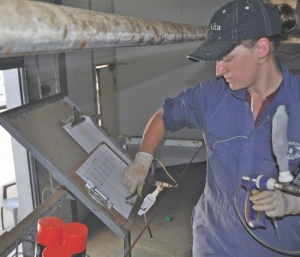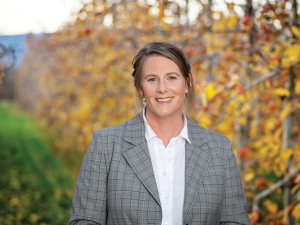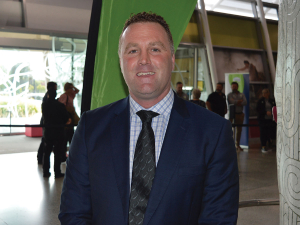To guarantee a constant supply throughout the year the dairy operation has streamlined every aspect of its year-round breeding programme.
Eighteen months ago the entire Fixed Time AI programme was contracted out to breeding specialists Nu-Genes which now manages and implements the programme, which involves joining up to 100 cows each week.
For farm manager Jim Simpson the benefit of this change in responsibilities is measured by better conception rates. “It certainly costs us to have Nu-Genes out here every week, but with their skills we get higher conception rates,” he said. “We’re able to deploy our own staff into other areas of farm management.”
Adam Quarrell from Nu-Genes manages the programme and is on farm three mornings a week. Using Bayer fertility regulators to synchronise cow ovulation, the breeding programme starts with a PG (prostaglandin) injection when the fresh cows are 37-43 days in milk. This stimulates cycling in the cow and is followed by a second injection 14 days later to catch any cows that didn’t start cycling first time round.
About 40 fresh cows 73-79 days in milk are inseminated every Thursday of the year. To minimise disruption to the herd’s feeding routine and other farm work, all the AI work is undertaken at milking time on the rotary platform.
“The Fixed Time AI programme enables us to predict everything on particular days,” Quarrell said. “We are at the dairy three mornings a week and achieve the same or better results than a more labour intensive heat detection programme.”
A heat detection programme would require an experienced person to be present seven hours a day. This person can be better utilised in another area of the business.
With a FTAI programme, every treatment stage is predicted for a particular day. All joining activity is concentrated into a six week period in which cows get up to three chances to conceive to AI.
“After that we only have three choices,” he said. “We can put them out with the bull, AI them one more time or put them in the DNB (do not breed) group and milk them until they are not paying their way.”
The programme is driven almost entirely by pregnancies and there is a meticulous focus on system compliance. “The key to success is being absolutely on top of compliance,” said Quarrell. “That means making sure it’s the right cow, the right injection and the right time.”
Attention to detail is paramount as is rigorous record keeping. “We need to make sure it’s the right cow and not one that’s already pregnant; that she’s had enough days in milk after calving to be ready to start cycling again and that we give her the right drug, in the right volume, with the right equipment.
“It can’t be yesterday or tomorrow because if we missed five out of 100 we would be down to 95% compliance. When you work that out over a herd of 1500 we would have missed 75 submissions.”
Achieving as close to 100% compliance as possible ensures conception rates are generally about 40%.
A good understanding of the dollar value of what they are doing with the breeding programme is important. Fertility regulators can be costly so volumes must be measured and targeted to each animal to get 100% effectiveness and a satisfactory return on investment.
Quarrell said their success is based on good management of what they can control. This is achieved by making sure all records are up to date and by having good communication with the farm management team so they know where each cow is up to when it comes on to the farm.
“By working together they can do what they do best and we do what we do best,” Quarrell said. “These programmes require precision. Managing irrigation, cow health, hay contractors, feeding and the 101 other jobs on the farm interrupt the synchronisation programme. To get it right you can’t afford distractions.”
Achieving satisfactory breeding results requires constant attention. There is always room for improvement. For instance, during the recent summer there was a drop in conception rates due entirely to the heat affecting the cows. Simpson thinks this kind of situation may need to be managed differently.
“While we are seeing good results from the fixed time AI programme, we may need to build greater flexibility into the system to cope with factors outside our control,” he said. “Good communication between breeding contractors and farm management is needed to address these and similar issues as they arise. Success is always a work in progress.”









